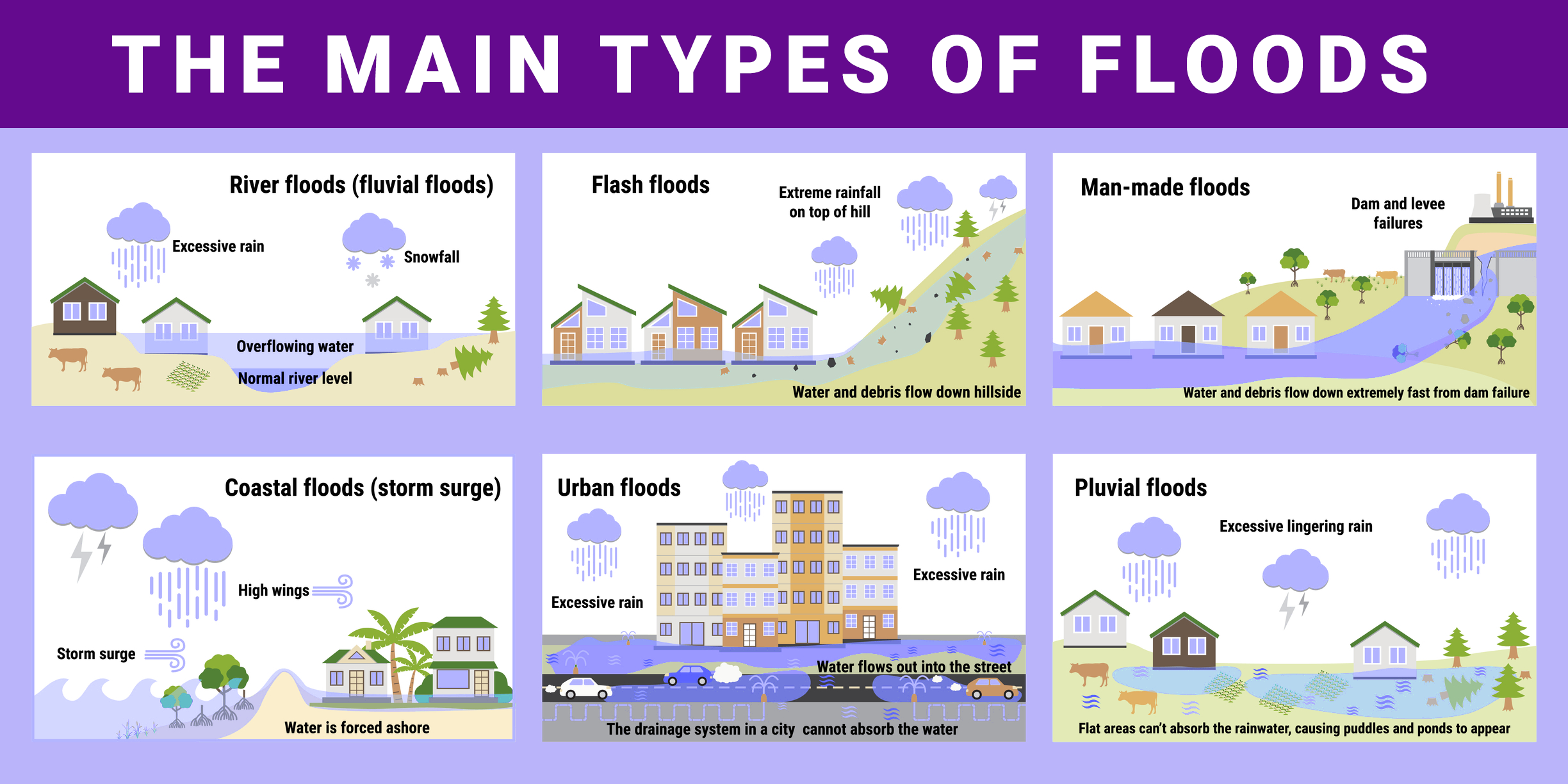Flood Alerts Explained: Understanding And Preparing For Flood Risks

Table of Contents
Understanding Flood Alerts and Warning Systems
Effective flood preparedness begins with a thorough understanding of flood alert systems. Knowing the difference between alert types and where to find reliable information is critical.
Different Types of Flood Alerts
Flood alerts aren't all created equal. Understanding the nuances of each type is vital for appropriate action:
-
Flood Watch: A flood watch means that conditions are favorable for flooding. While flooding isn't imminent, it's possible, and you should monitor the situation closely and be prepared to take action. This is the time to review your emergency plan and ensure you're ready.
-
Flood Warning: A flood warning is serious. Flooding is happening now, or will happen very soon. Immediate action is required. Evacuation may be necessary.
-
Flood Advisory: A flood advisory indicates that minor flooding is occurring or is expected. While the threat is less severe than a warning, it still warrants caution. Be aware of potential hazards and avoid unnecessary travel in affected areas.
Sources of Flood Alerts
Reliable information is paramount. You can receive flood alerts from several sources:
-
National Weather Service (NWS): The NWS is the primary source for weather-related alerts, including flood warnings and watches. Visit weather.gov for alerts specific to your location.
-
Local News: Many local news stations provide up-to-the-minute weather reports and alerts, often including specific flood information for your area.
-
Weather Apps: Numerous weather apps (like AccuWeather, The Weather Channel, and more) offer customized alerts, including push notifications for flood warnings and watches. Ensure your location settings are accurate for precise alerts.
-
Emergency Alert System (EAS): The EAS broadcasts urgent alerts, including flood warnings, via radio, television, and sometimes wireless emergency alerts to your mobile device.
Sign up for email or text-based alerts through your local government's emergency management agency for personalized and timely notifications. This is often the quickest way to receive urgent flood warnings.
Interpreting Flood Alert Information
Flood alerts provide crucial information. Pay close attention to:
-
Location: The specific areas affected by the flood alert. Even a slight variation in location can significantly impact your risk.
-
Severity: The level of flooding (minor, moderate, major). This helps gauge the urgency of the situation.
-
Timing: When the flooding is expected to begin and end. Knowing the timeframe allows for better preparation and response.
For example, an alert might read: "Flood Warning issued for [County Name]: Major flooding is occurring along the [River Name] near [City Name]. Evacuate immediately."
Preparing for Floods Based on Flood Alerts
Proactive preparation is key to minimizing flood damage and ensuring your safety. Don't wait for a flood to start preparing!
Developing a Flood Preparedness Plan
Having a detailed plan in place before a flood is vital:
-
Identify Evacuation Routes: Know multiple routes out of your home and neighborhood, considering potential road closures.
-
Secure Valuable Items: Move important documents, electronics, and other valuables to higher ground or a safe location.
-
Prepare an Emergency Kit: This should include essential supplies like water, non-perishable food, first-aid kit, medications, flashlights, and a portable radio. [Link to FEMA resource on emergency kits]
-
Make Contact Plans: Designate an out-of-area contact person to check in with family members after the flood.
Protecting Your Property from Flood Damage
Preventative measures can significantly reduce flood damage:
-
Elevate Appliances: Move electrical appliances, furnaces, and water heaters to higher ground to prevent damage.
-
Install Flood Barriers: Consider installing flood barriers or sandbags around your property, particularly if you live in a high-risk area.
-
Purchase Flood Insurance: Flood insurance is often not included in standard homeowner's insurance policies. Obtaining flood insurance provides vital financial protection against flood damage.
Evacuation Procedures During a Flood Warning
When a flood warning is issued, evacuation is often necessary. Ignoring warnings can be extremely dangerous:
-
Evacuate Immediately: Don't delay when instructed to evacuate. Floodwaters can rise rapidly and become life-threatening.
-
Follow Official Instructions: Obey all instructions from emergency officials, including designated evacuation routes.
-
Secure Your Home: Turn off utilities, including gas, electricity, and water, before leaving.
Flood Safety and Post-Flood Actions
Staying safe during and after a flood is paramount.
Staying Safe During a Flood
During a flood event:
-
Avoid Floodwaters: Floodwaters are often contaminated with sewage, chemicals, and debris. Never drive or walk through floodwaters.
-
Stay Away from Downed Power Lines: Downed power lines pose a severe electrocution risk. Report downed lines immediately to the authorities.
-
Seek Higher Ground: If trapped by rising floodwaters, seek higher ground immediately.
Post-Flood Recovery
After the flood:
-
Contact Your Insurance Company: Report flood damage to your insurance provider as soon as possible.
-
Clean Up Safely: Use caution when cleaning up, wearing protective gear to avoid exposure to contaminants. Professional cleanup may be necessary for mold and other hazards.
-
Seek Assistance: Contact your local government's emergency management agency for assistance with recovery efforts. [Link to FEMA resources for flood assistance]
Conclusion
Understanding and heeding flood alerts is critical for mitigating the risks associated with flooding. By developing a comprehensive flood preparedness plan and utilizing reliable information sources such as the National Weather Service and local news, you can significantly reduce your risk and protect yourself and your property. Remember the key takeaways: recognize the differences between flood watches, warnings, and advisories, develop a robust preparedness plan, and always prioritize safety during and after a flood. Don't wait for a flood; prepare now and sign up for flood alerts near you today! Search for "national flood alerts" or "local flood warnings" to find resources relevant to your area.

Featured Posts
-
 Voici L Avenir Des Locaux De La Rtbf Au Palais Des Congres De Liege
May 26, 2025
Voici L Avenir Des Locaux De La Rtbf Au Palais Des Congres De Liege
May 26, 2025 -
 Confirmation Ou Dementi L Avenir De La Semaine Des 5 Heures Sur La Premiere
May 26, 2025
Confirmation Ou Dementi L Avenir De La Semaine Des 5 Heures Sur La Premiere
May 26, 2025 -
 L Affaire Qui A Sonne Le Glas Des Ambitions De Marine Le Pen
May 26, 2025
L Affaire Qui A Sonne Le Glas Des Ambitions De Marine Le Pen
May 26, 2025 -
 La Famille Luthers En Deuil Suite Au Deces D Albert
May 26, 2025
La Famille Luthers En Deuil Suite Au Deces D Albert
May 26, 2025 -
 Klasemen Moto Gp Terbaru Jadwal Balapan Silverstone And Performa Marquez
May 26, 2025
Klasemen Moto Gp Terbaru Jadwal Balapan Silverstone And Performa Marquez
May 26, 2025
